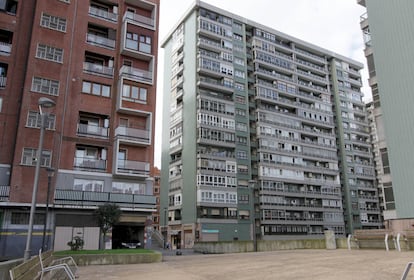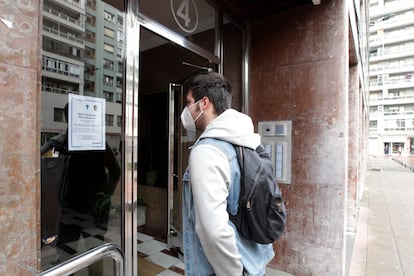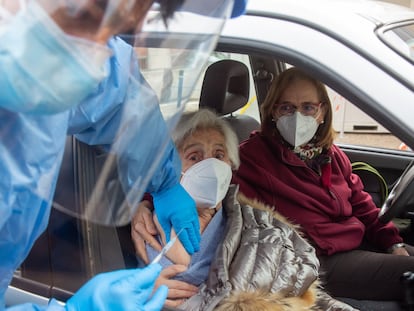Architecture of an outbreak: the Spanish apartment building hijacked by the coronavirus
Six people are dead and dozens more infected after the virus moved undetected through a 16-story residential property in the Basque city of Bilbao

6
deaths
2
hospitalizations
25
self-isolating at home
Barakaldo
Bilbao
Basauri
There are six affected floors with positive Covid-19 cases
The building has 64 apartments, four on each floor
15
13
Death of an
84-year-old
woman
11
9
Death of an
85-year-old
woman and her
50-year-old son
Elevators
Stairs
4
Death of an
88-year-old
man
Death of two
brothers (73 and
75 years old)
1
Entrance 5
Offices and
commercial
premises
Haro Square
Entrance 4
Commercial
premises
Source: Bizkaia land register and in-house.
N. C. / EL PAÍS

6
deaths
2
hospitalizations
25
self-isolating at home
Barakaldo
Bilbao
Basauri
There are six affected floors with positive Covid-19 cases
The building has 64 apartments, four on each floor
15
13
Death of an
84-year-old
woman
11
9
Death of an
85-year-old
woman and her
50-year-old son
Elevators
Stairs
4
Death of an
88-year-old
man
Death of two
brothers (73 and
75 years old)
1
Entrance 5
Offices and
commercial
premises
Haro Square
Entrance 4
Commercial
premises
Source: Bizkaia land register and in-house.
N. C. / EL PAÍS

6
deaths
2
hospitalizations
25
self-isolating at home
There are six affected floors with positive Covid-19 cases
15
13
Barakaldo
Death of an
84-year-old
woman
Bilbao
11
Basauri
Death of an
85-year-old
woman and her
50-year-old son
9
Elevators
Stairs
The building has 64 apartments, four on each floor
Death of an
88-year-old
man
4
Death of two
brothers (73 and
75 years old)
1
Santa Clara Street
Entrance 5
Offices and commercial
premises
Haro Square
Entrance 4
Commercial premises
Source: Bizkaia land register and in-house.
N. C. / EL PAÍS
The people who live in the 16-story apartment building located at No. 4 Haro Square, in the Basque city of Bilbao, have been plagued by the coronavirus since mid-January. In the space of two weeks, an outbreak among residents and their close contacts has led to 33 positive cases, six of whom have since died.
The Basque health department and several experts believe that a super-spreader may have started the outbreak, with the virus further expanding through the use of the building’s two elevators, which can each accommodate five people.
The first alarm went off on January 21, when an 85-year-old woman living on the ninth floor died from Covid-19. But it was not until two days later that her neighbors began to realize that they had a serious problem on their hands. On January 23, the elderly woman’s 50-year-old son also died, a tragedy that was brought to the notice of the building manager the following day.
With help from the residents, the manager hired a cleaning company that proceeded to disinfect the communal areas on the night of January 26, at a cost of €700. On January 27, residents were living in a clean building for the first time since January 9, when the Basque department of health had been informed of the first positive case.
But that day there was further sad news: an 84-year-old woman living on the 11th floor had died overnight. Two brothers from the first floor, aged 73 and 75, passed away the following Saturday. And the Basque health chief, Gotzone Sagardui, recently confirmed the death of a sixth person on February 8.
Health authorities were informed of the first positive case in the building on January 9, but it wasn’t until the 26th that the communal areas were disinfected and properly ventilated. During the 17 days in between, the virus was able to circulate freely with the help of the building’s two elevators. The first time authorities stepped in was on January 25, when they carried out tests on the residents and their close contacts.

The case of the Bilbao building reminds José Jiménez, a researcher at the Department of Infectious Diseases at King’s College London, of what was known as “ground zero” during a 2003 outbreak of another coronavirus named SARS, which generated its own health crisis. The Chinese doctor Liu Jianlun was staying on the 9th floor of the Metropole Hotel in Hong Kong where he infected 16 people who then spread the virus to Canada, Vietnam, Singapore and Taiwan. It is suspected that the spread took place in communal areas, perhaps via the elevator button for the ninth floor, which was touched by all those who became infected.
As in the Metropole Hotel case, the positive cases at the Bilbao building continued to lead normal lives until they began to experience symptoms, which is when the regional health department began to monitor their condition. But the other residents were not notified about the growing number of cases. Some living on the ninth floor took their pets out for a walk two or three times a day while others went about their usual business, going to work and doing the shopping, with no restrictions other than the basic measures of wearing a face mask and washing their hands.
Among the close contacts of the residents to have caught the virus was another one of the first victim’s children, who is thought to have become infected while visiting his mother and brother to walk the dog when they were in quarantine and then subsequently hospitalized. Another infection probably occurred on January 24, when a neighbor entered a friend’s apartment on the 11th floor to check on her. He and his wife were hospitalized but have since been discharged. Although the Basque department of health has not specified how many of the 33 positive cases live in the building and how many are close contacts of those who do, at least half of them were residents, according to a count made by those living there, who said the positive cases were found on the first, fourth, ninth, 11th, 13th and 15th floors.

“There are people who have a very high viral load and who infect more than the average person because of their social activity,” Jiménez explains, referring to super-spreaders. “If one of them uses the elevator a lot, that could be the focus of contagion.” But he also believes that there may be a different explanation, or at least an additional one: “It could be that the building’s ventilation is connected and is very poor, as is often the case in bathrooms. Something similar happened in South Korea.”
The affected property in Bilbao was built in 1973. Only one wing has a small courtyard and the neighbors report no construction problems, such as connected extraction fans. Neither was it the case that one of the elevators was reserved for the even-numbered floors and another for the odd-numbered floors, which would have explained the higher incidence of positives on the odd-numbered floors. The people on all the floors breathed the same air and touched the same surfaces in the communal areas between January 9 and the day that the building was cleaned on January 26, by which time three people had already died.
Pets
Experts believe it is unlikely that the dog of the infected family had a direct role in the transmission of the virus. Pedro Gullón, from the Spanish Society of Epidemiology, explains that there is no evidence that pets can infect humans. “If it was the case, it would be because they were behaving like surfaces,” he says, alluding to the probability of getting infected by touching inanimate objects, which is now believed to be much lower than previously thought. “But there is no evidence that pets are playing an epidemiological role in the spread of human SARS-CoV-2 infections.”
However, the World Organisation for Animal Health recommends that people with suspected or confirmed Covid-19 should avoid close contact with their pets and have another member of the household take care of them while exercising precaution through hygiene practices and the use of masks.
The regional department of health has ruled out the B.1.1.7 strain of the virus as being at the origin of the outbreak, as was initially suggested. It adds that it is investigating the case and that “epidemiological monitoring” of the outbreak is ongoing. It has not, however, specified the results of its most recent tests. “There are still quarantined and hospitalized residents,” said a spokesperson for the department.
“It’s unlikely we’re going to return to normality any time soon,” says one resident. “I feel sorry for the victims, for the residents who have been affected, and I feel upset by how scared we feel, but I also feel sorry for the businesses in the square that are losing customers because of the alarm surrounding the case.”
Access to the building’s main entrance is in a corner of the square. The door is now permanently open, as are the windows on the landings between floors. Four young people sip coffee on one of the concrete benches in the square. “We all have to learn from this,” says the building manager.
English version by Heather Galloway.
Tu suscripción se está usando en otro dispositivo
¿Quieres añadir otro usuario a tu suscripción?
Si continúas leyendo en este dispositivo, no se podrá leer en el otro.
FlechaTu suscripción se está usando en otro dispositivo y solo puedes acceder a EL PAÍS desde un dispositivo a la vez.
Si quieres compartir tu cuenta, cambia tu suscripción a la modalidad Premium, así podrás añadir otro usuario. Cada uno accederá con su propia cuenta de email, lo que os permitirá personalizar vuestra experiencia en EL PAÍS.
¿Tienes una suscripción de empresa? Accede aquí para contratar más cuentas.
En el caso de no saber quién está usando tu cuenta, te recomendamos cambiar tu contraseña aquí.
Si decides continuar compartiendo tu cuenta, este mensaje se mostrará en tu dispositivo y en el de la otra persona que está usando tu cuenta de forma indefinida, afectando a tu experiencia de lectura. Puedes consultar aquí los términos y condiciones de la suscripción digital.
More information
Últimas noticias
Most viewed
- David King, chemist: ‘There are scientists studying how to cool the planet; nobody should stop these experiments from happening’
- Reinhard Genzel, Nobel laureate in physics: ‘One-minute videos will never give you the truth’
- Mexico completes its trade shift with the entry into force of tariffs on China and countries without trade agreements
- Oona Chaplin: ‘I told James Cameron that I was living in a treehouse and starting a permaculture project with a friend’
- Sinaloa Cartel war is taking its toll on Los Chapitos










































